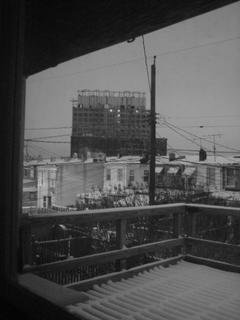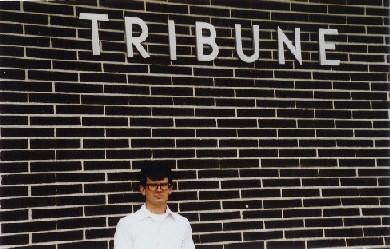Round here--Part One of a Few: The Silo
My temptation is to turn every first thing into some sort of manifesto, but that is tedious, and sometimes I try not to be tedious, and I began posting things here in a vague way with vague ideas etc etc etc...but tonight I figure I would just begin with the neighborhood.
Baltimore is neighborhoods. I have lived in other cities, and some (Pittsburgh particularly) are neighborhoods in ways similar to Baltimore--unlike the city where I grew up, San Jose, which has maybe two, three neighborhoods people know the names of. Did you know that San Jose is the third-largest city in California? Mm hmm.
Baltimore is neighborhoods, and the one we live in right now is Locust Point, formerly Whetstone Point.
Allegedly, heroin is a problem down here. One night over pints at J. Patrick's down on Andre a longtime local praised the neighborhood like this: "Yeah, you could leave your front door unlocked--I wouldn't--but you could if you wanted to. All our druggies have jobs, so they don't need to steal for money..."
The tallest structure here is this: In 2001 it closed for good. Archer Daniels Midland owned and operated it, until the pier leading from it to the water collapsed. There was some argument over who should fix the pier, and ADM figured it was cheaper just to walk away. Now a developer (notice the crane jutting up from the middle of the silo complex) is turning it into a shopping mall and condos or some such thing. If you were to look out from our bedroom, you would see this:
In 2001 it closed for good. Archer Daniels Midland owned and operated it, until the pier leading from it to the water collapsed. There was some argument over who should fix the pier, and ADM figured it was cheaper just to walk away. Now a developer (notice the crane jutting up from the middle of the silo complex) is turning it into a shopping mall and condos or some such thing. If you were to look out from our bedroom, you would see this:
 The people who are trying to turn this former grain storage facility into living space hollowed out the silo complex in order to build a parking garage in the middle. There was half-joking talk in the neighborhood of a six foot deep tide of rats flooding the streets when the work began--but only half-joking, as you might imagine. A sort of vermin-gallows humor. No such thing happened, probably to the disappointment of some of the old-timers in the neighborhood. They would have appreciated the irony and the spectacle, if not the actual rats.
The people who are trying to turn this former grain storage facility into living space hollowed out the silo complex in order to build a parking garage in the middle. There was half-joking talk in the neighborhood of a six foot deep tide of rats flooding the streets when the work began--but only half-joking, as you might imagine. A sort of vermin-gallows humor. No such thing happened, probably to the disappointment of some of the old-timers in the neighborhood. They would have appreciated the irony and the spectacle, if not the actual rats.
A statistic floating around a couple of years ago informed us that there were five rats for every man, woman, and child in Baltimore. Beth, of course, wondered, "What happens if you move? Do you get to keep your five rats? Or do you leave them for someone new moving to the city? Who watches your rats when you go on vacation?" Etc.
Surrounding this building is the development of several brand new blocks of townhouses, priced these days over 500 Grand. Most of them were sold, of course, before the graders had even smoothed out the industrial vacant lot dirt. I would guess that before each one is actually occupied by people, it will have been sold two or three times, and each seller will have made a killing.
Father Ray, priest at Our Lady of Good Counsel, talking about these new homes and their certain effect on the values of existing homes here, said once, "It's the end of Locust Point as we know it."
Even this neighborhood has neighborhoods. A couple of weeks after we moved in, we stopped a couple of doors down to exchange greetings with some neighbors. There were two older women, an older man, and a younger family--man, woman, toddler (I did not ask them about their 15 rats), all out on the stoop.
"Hi, hon. I'm Peachy."
"My name's Dolores, but nobody calls me that. Everybody calls me Dickie."
The older man remained quiet and nodded.
The young father introduced himself, his wife, and their child. I asked if he lived here. He answered, "No, we live over on Richardson. We're just visiting."
Richardson is the very next street over.
Many of the homes in Locust Point have never been sold.
Baltimore is neighborhoods. I have lived in other cities, and some (Pittsburgh particularly) are neighborhoods in ways similar to Baltimore--unlike the city where I grew up, San Jose, which has maybe two, three neighborhoods people know the names of. Did you know that San Jose is the third-largest city in California? Mm hmm.
Baltimore is neighborhoods, and the one we live in right now is Locust Point, formerly Whetstone Point.
Allegedly, heroin is a problem down here. One night over pints at J. Patrick's down on Andre a longtime local praised the neighborhood like this: "Yeah, you could leave your front door unlocked--I wouldn't--but you could if you wanted to. All our druggies have jobs, so they don't need to steal for money..."
The tallest structure here is this:
 In 2001 it closed for good. Archer Daniels Midland owned and operated it, until the pier leading from it to the water collapsed. There was some argument over who should fix the pier, and ADM figured it was cheaper just to walk away. Now a developer (notice the crane jutting up from the middle of the silo complex) is turning it into a shopping mall and condos or some such thing. If you were to look out from our bedroom, you would see this:
In 2001 it closed for good. Archer Daniels Midland owned and operated it, until the pier leading from it to the water collapsed. There was some argument over who should fix the pier, and ADM figured it was cheaper just to walk away. Now a developer (notice the crane jutting up from the middle of the silo complex) is turning it into a shopping mall and condos or some such thing. If you were to look out from our bedroom, you would see this: The people who are trying to turn this former grain storage facility into living space hollowed out the silo complex in order to build a parking garage in the middle. There was half-joking talk in the neighborhood of a six foot deep tide of rats flooding the streets when the work began--but only half-joking, as you might imagine. A sort of vermin-gallows humor. No such thing happened, probably to the disappointment of some of the old-timers in the neighborhood. They would have appreciated the irony and the spectacle, if not the actual rats.
The people who are trying to turn this former grain storage facility into living space hollowed out the silo complex in order to build a parking garage in the middle. There was half-joking talk in the neighborhood of a six foot deep tide of rats flooding the streets when the work began--but only half-joking, as you might imagine. A sort of vermin-gallows humor. No such thing happened, probably to the disappointment of some of the old-timers in the neighborhood. They would have appreciated the irony and the spectacle, if not the actual rats.A statistic floating around a couple of years ago informed us that there were five rats for every man, woman, and child in Baltimore. Beth, of course, wondered, "What happens if you move? Do you get to keep your five rats? Or do you leave them for someone new moving to the city? Who watches your rats when you go on vacation?" Etc.
Surrounding this building is the development of several brand new blocks of townhouses, priced these days over 500 Grand. Most of them were sold, of course, before the graders had even smoothed out the industrial vacant lot dirt. I would guess that before each one is actually occupied by people, it will have been sold two or three times, and each seller will have made a killing.
Father Ray, priest at Our Lady of Good Counsel, talking about these new homes and their certain effect on the values of existing homes here, said once, "It's the end of Locust Point as we know it."
Even this neighborhood has neighborhoods. A couple of weeks after we moved in, we stopped a couple of doors down to exchange greetings with some neighbors. There were two older women, an older man, and a younger family--man, woman, toddler (I did not ask them about their 15 rats), all out on the stoop.
"Hi, hon. I'm Peachy."
"My name's Dolores, but nobody calls me that. Everybody calls me Dickie."
The older man remained quiet and nodded.
The young father introduced himself, his wife, and their child. I asked if he lived here. He answered, "No, we live over on Richardson. We're just visiting."
Richardson is the very next street over.
Many of the homes in Locust Point have never been sold.


4 Comments:
Keep 'em coming.
Yes, neighborhoods within neighborhoods...but what about parishes as sub-sections of neighborhoods? (St. Paul!)
Yes, most neighborhoods divide themselves into smaller, or overlapping jurisdictions of one kind or another. The thing about Locust Point is the intensity of the localism. Older people here still talk about there being little reason to go "up the hill" to Federal Hill, which is about a mile away. Each street here on the Point is its own neighborhood. And each block of each street has its own character.
Dude, Pineapple City has nothing on Washington when it comes to neighborhoods. Like, there's George Washington Circle, where everybody drives Mercedeses. Over in George Washington Square, they all drive Lexuses. In Reagan Heights, they all drive Cadillac Escalades. In Reagan Park they drive Lincolns.
Top that!
Post a Comment
<< Home